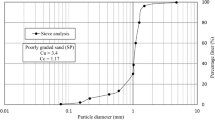In this paper, the causes and mechanisms of residual loads are described and discussed. Methods for measuring pile residual loads in the field are summarized and compared. Specifically, a driven pile and a bored pile were selected to show the effects of residual loads on skin frictions and toe resistances. The results indicate that the skin friction in the upper pile portion and the vertical compressive stiffness of the test piles are overestimated, while the toe resistance is underestimated, if the residual loads are ignored.
Similar content being viewed by others
References
R. S. Nie, W. M. Leng, Q. Yang, and W. Wei, "Discusion on the shear stress transfer between pile and soil," Rock Soil Mech., 30(3), 799-804 (2009).
R. S. Nie and W. M. Leng, "Field test of negative skin friction on bridge abutment pile foundation in soft ground," Railway Eng., No. 6, 1-4 (2005).
R. S. Nie and W. M. Leng, "Vertical bearing behavior of single pile subject to negative skin friction," J. Central South Univ. (Sci. and Tech.), 44(4), 1539-1544 (2013).
R. S. Nie, W. M. Leng, A. H. Wu, F. Q. Li, and Y. F. Chen, "Field measurement and analysis of residual stress in bored piles," J. Highway Transp. Res. Dev. (Eng. Ed.), 8(4), 57-62 (2014).
B. H. Fellenius, "Determining the resistance distribution in piles. Part 1: notes on shift of no-load reading and residual load," Geotech. News Mag., 20(2), 35-38 (2002).
B. H. Fellenius, "Determining the resistance distribution in piles. Part 2: method for determining the residual load," Geotech. News Mag., 20(3), 25-29 (2002).
J. Briaud and L. Tucker, "Piles in sand: a method including residual stresses," J. Geotech. Eng., 110(11), 1666-1680 (1984).
H. G. Poulos, "Analysis of residual stress effects in piles," J. Geotech. Eng., 113(3), 216-229 (1987).
A. S. Alawneh, O. Nusier, A. I. Husein Malkawi, and M. Al-Kateeb, "Axial compressive capacity of driven piles in sand: a method including post-driving residual stresses," Can. Geotech. J., 38, 364-377 (2001).
R. L. Nordlund, "Bearing capacity of piles in cohesionless soils," J. Soil Mech. Found. Eng., 89(SM3), 1-35 (1963).
O. S. Gregersen, G. Aas, and E. Dibiagio, "Load tests on friction piles in loose sand," Proc. of the 8th Int. Conf. on Soil Mechanics and Foundation Engineering, Moscow, Vol. 2.1, 109-117 (1973).
B. H. Fellenius, S. R. Kim, and S. G. Chung, "Long-term monitoring of strain in instrumented piles," J. Geotech. Geoenviron. Eng., 135(11), 1583-1595 (2009).
J. Dunnicliff, Geotechnical Instrumentation for Monitoring Field Performance, John Wiley & Sons, New York (1988).
B. Glisic, D. Inaudi, and C. Nan. "Pile monitoring with fiber optic sensors during axial compression, pullout, and flexure tests," Transport. Res. Rec. 1808, 11-20 (2002).
G. Q. Wei, B. Shi, J. X. Jia, S. Hu, K. Li, and D. Zhang, "Application of distributed optical fiber sensing to testing inner force of prefabricated piles," Chin. J. Geotech. Eng., 31(6), 911-916 (2009).
H. M. A. Aziz and S. K. Lee, "Innovation in instrumented test piles in Malaysia: application of global strain extensometer (GLOSTREXT) method for instrumented bored piles in Malaysia," Bull. Inst. Eng., Malaysia, 10, 10-19 (2005).
F. H. Ali and S. K. Lee "A new technique for driven piles instrumentation," Geotech. Test. J., 33(6), 1-8 (2010).
Author information
Authors and Affiliations
Additional information
Translated from Osnovaniya, Fundamenty i Mekhanika Gruntov, No. 2, p. 13, March-April, 2018.
Rights and permissions
About this article
Cite this article
Nie, R., Leng, W., Yang, Q. et al. Effects of Pile Residual Loads on Skin Friction and Toe Resistance. Soil Mech Found Eng 55, 76–81 (2018). https://doi.org/10.1007/s11204-018-9506-4
Published:
Issue Date:
DOI: https://doi.org/10.1007/s11204-018-9506-4




